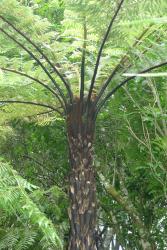- = Sphaeropteris Bernh., J. Bot. (Schrader) 1800(2): 122, t. 1(1) (1801)
- = Alsophila R.Br., Prodr. Fl. Nov. Holland. 158 (1810)
- = Hemitelia R.Br., Prodr. Fl. Nov. Holland. 158 (1810)
Terrestrial ferns. Rhizomes usually forming an arborescent trunk covered in adventitious roots and either persistent stipe bases or stipe scars, or rarely prostrate and creeping; bearing scales at the apex. Rhizome scales conform or marginate, either bearing a single dark-coloured apical seta, or bearing setae along the scale margins or on the scale surfaces, or lacking dark-coloured setae. Fronds monomorphic. Stipes bearing scales, either directly on the stipe surface or on low to prominent tubercles, sometimes also hairy. Laminae 2-pinnate to 3-pinnate-pinnatifid (NZ) or rarely entire or 1-pinnate (not NZ), catadromous, herbaceous to coriaceous, bearing scales similar to those of the rhizome, and usually also multi-cellular hairs. Sori round, borne on abaxial surface away from margins; paraphyses present; indusia either absent, forming a saucer-like structure at the base of the receptacle, forming a cup or hood-shaped structure around the sorus, or completely enclosing the sorus and rupturing irregularly at maturity; receptacles slightly to strongly elevated, sporangia maturing in gradate sequence. Spores trilete, radially symmetrical; exospores sometimes pitted; perispores granulate, with coarse echinae or slender rodlets, or sometimes very thin.
A genus of about 500 species. The Australasian and Pacific species of Cyathea sensu lato were revised by Holttum (1964) and his treatment is largely followed here. Allan (1961) was uncertain about C. cunninghamii in New Zealand, suggesting that some specimens might be hybrids between C. medullaris and C. smithii. However, Brownsey (1979) confirmed the presence of C. cunninghamii in New Zealand and illustrated the distinguishing features of all three species. No hybrids involving C. medullaris are accepted. The status of the two Raoul Island endemics, C. kermadecensis and C. milnei, has been discussed by Brownsey & Perrie (2015).
| 1 | Stipe and lamina scales with dark-coloured spines at the apices and on the margins; trunks bearing hexagonal or oval stipe scars | 2 |
| Stipe and lamina scales lacking dark-coloured spines, or spines confined to the apices, or borne on the scale surface; trunks occasionally absent, or when present, usually bearing projecting remnants of stipe bases | 3 | |
| 2 | Stipes black; indusia completely covering the sori when young, splitting irregularly at maturity; hairs in sorus inconspicuous, shorter than or equalling the sporangia | medullaris |
| Stipes pale brown; indusia absent; hairs in sorus conspicuous, equalling or longer than the sporangia | cooperi | |
| 3 | Indusia absent; hairs in sorus conspicuous, longer than sporangia; trunks prostrate, or less than 1m tall at maturity | colensoi |
| Indusia present; hairs in sorus inconspicuous, shorter than sporangia; trunks several metres tall at maturity | 4 | |
| 4 | Abaxial surface of lamina bearing abundant curly hairs; indusia covering sori when young, opening to form a deep cup at maturity | 5 |
| Abaxial surface of lamina lacking obvious curly hairs; indusia covering sori when young, opening to a hood-shape or saucer-shape at maturity | 6 | |
| 5 | Abaxial surface of lamina white, blue-green or grey-green; scales very scattered or absent on abaxial surface of costae; stipe bases rough; plants of main islands | dealbata |
| Abaxial surface of lamina green; scales abundant on abaxial surface of costae; stipe bases conspicuously tuberculate; plants confined to Kermadec Islands | milnei | |
| 6 | Stipes and rachises of dead fronds forming a persistent skirt around trunk on mature plants; indusia saucer-shaped, forming less than half a sphere at maturity | smithii |
| Stipes and rachises not persistent on mature plants; indusia hood-shaped, forming more than half a sphere at maturity | 7 | |
| 7 | Tertiary pinnae deeply divided; abaxial surface of lamina bearing red or white acaroid scales, usually lacking irregularly curled acicular hairs; plants of main islands | cunninghamii |
| Tertiary pinnae crenate or almost undivided; abaxial surface of lamina bearing only white acaroid scales and irregularly curled acicular hairs; plants confined to Kermadec Islands | kermadecensis |
Throughout the tropics and south temperate regions. Of the groups identified by Korall et al. (2007), Sphaeropteris extends from India through south-east Asia to Australia, New Zealand and the tropical Pacific, with about eight species also in Central and South America; Cyathea sensu stricto occurs predominantly in Central and South America, but also occurs from New Guinea and Queensland through the tropical Pacific to the Austral Islands. The delimitation of Alsophila and Gymnosphaera is not clear, but Alsophila apparently extends through tropical and southern Africa, India, China, south-east Asia, Australia, New Zealand, the tropical Pacific, Central and South America, while Gymnosphaera occurs from Madagascar through India, south-east Asia to Australia and presumably into the Pacific, with a single species also in Mexico (Conant et al. 1995; Large & Braggins 2004b; Korall et al. 2007). Five endemic, two indigenous and one species casual in New Zealand.
| Category | Number |
|---|---|
| Indigenous (Endemic) | 5 |
| Indigenous (Non-endemic) | 2 |
| Exotic: Fully Naturalised | 1 |
| Total | 8 |
The base chromosome number in Cyathea is n = 69 (Kramer 1990).




